Gavin Zhang
Preconditioned Gradient Descent for Over-Parameterized Nonconvex Matrix Factorization
Apr 13, 2025Abstract:In practical instances of nonconvex matrix factorization, the rank of the true solution $r^{\star}$ is often unknown, so the rank $r$ of the model can be overspecified as $r>r^{\star}$. This over-parameterized regime of matrix factorization significantly slows down the convergence of local search algorithms, from a linear rate with $r=r^{\star}$ to a sublinear rate when $r>r^{\star}$. We propose an inexpensive preconditioner for the matrix sensing variant of nonconvex matrix factorization that restores the convergence rate of gradient descent back to linear, even in the over-parameterized case, while also making it agnostic to possible ill-conditioning in the ground truth. Classical gradient descent in a neighborhood of the solution slows down due to the need for the model matrix factor to become singular. Our key result is that this singularity can be corrected by $\ell_{2}$ regularization with a specific range of values for the damping parameter. In fact, a good damping parameter can be inexpensively estimated from the current iterate. The resulting algorithm, which we call preconditioned gradient descent or PrecGD, is stable under noise, and converges linearly to an information theoretically optimal error bound. Our numerical experiments find that PrecGD works equally well in restoring the linear convergence of other variants of nonconvex matrix factorization in the over-parameterized regime.
Fast and Minimax Optimal Estimation of Low-Rank Matrices via Non-Convex Gradient Descent
May 26, 2023Abstract:We study the problem of estimating a low-rank matrix from noisy measurements, with the specific goal of achieving minimax optimal error. In practice, the problem is commonly solved using non-convex gradient descent, due to its ability to scale to large-scale real-world datasets. In theory, non-convex gradient descent is capable of achieving minimax error. But in practice, it often converges extremely slowly, such that it cannot even deliver estimations of modest accuracy within reasonable time. On the other hand, methods that improve the convergence of non-convex gradient descent, through rescaling or preconditioning, also greatly amplify the measurement noise, resulting in estimations that are orders of magnitude less accurate than what is theoretically achievable with minimax optimal error. In this paper, we propose a slight modification to the usual non-convex gradient descent method that remedies the issue of slow convergence, while provably preserving its minimax optimality. Our proposed algorithm has essentially the same per-iteration cost as non-convex gradient descent, but is guaranteed to converge to minimax error at a linear rate that is immune to ill-conditioning. Using our proposed algorithm, we reconstruct a 60 megapixel dataset for a medical imaging application, and observe significantly decreased reconstruction error compared to previous approaches.
Simple Alternating Minimization Provably Solves Complete Dictionary Learning
Oct 23, 2022Abstract:This paper focuses on complete dictionary learning problem, where the goal is to reparametrize a set of given signals as linear combinations of atoms from a learned dictionary. There are two main challenges faced by theoretical and practical studies of dictionary learning: the lack of theoretical guarantees for practically-used heuristic algorithms, and their poor scalability when dealing with huge-scale datasets. Towards addressing these issues, we show that when the dictionary to be learned is orthogonal, that an alternating minimization method directly applied to the nonconvex and discrete formulation of the problem exactly recovers the ground truth. For the huge-scale, potentially online setting, we propose a minibatch version of our algorithm, which can provably learn a complete dictionary from a huge-scale dataset with minimal sample complexity, linear sparsity level, and linear convergence rate, thereby negating the need for any convex relaxation for the problem. Our numerical experiments showcase the superiority of our method compared with the existing techniques when applied to tasks on real data.
Accelerating SGD for Highly Ill-Conditioned Huge-Scale Online Matrix Completion
Aug 24, 2022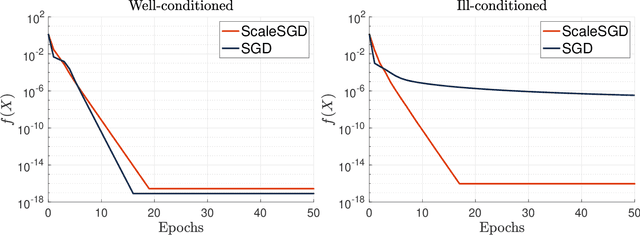
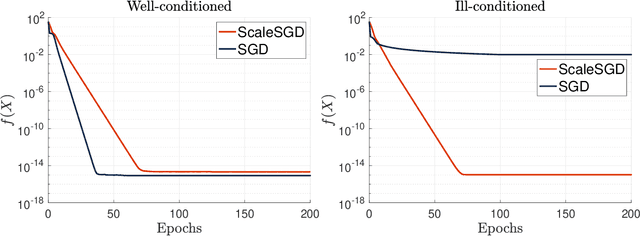
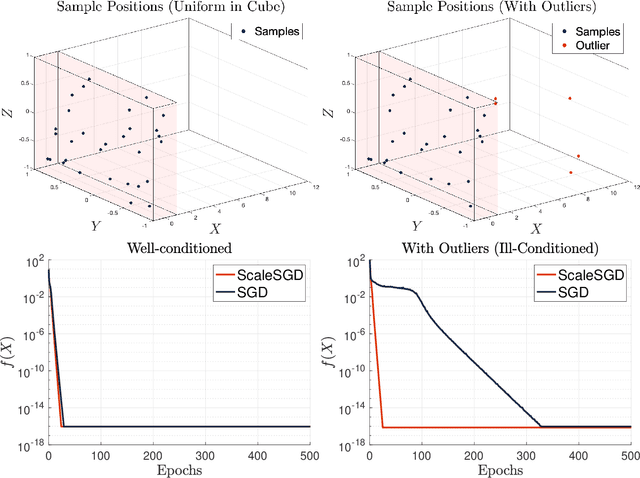
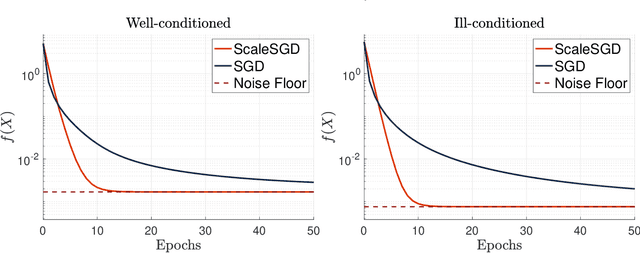
Abstract:The matrix completion problem seeks to recover a $d\times d$ ground truth matrix of low rank $r\ll d$ from observations of its individual elements. Real-world matrix completion is often a huge-scale optimization problem, with $d$ so large that even the simplest full-dimension vector operations with $O(d)$ time complexity become prohibitively expensive. Stochastic gradient descent (SGD) is one of the few algorithms capable of solving matrix completion on a huge scale, and can also naturally handle streaming data over an evolving ground truth. Unfortunately, SGD experiences a dramatic slow-down when the underlying ground truth is ill-conditioned; it requires at least $O(\kappa\log(1/\epsilon))$ iterations to get $\epsilon$-close to ground truth matrix with condition number $\kappa$. In this paper, we propose a preconditioned version of SGD that preserves all the favorable practical qualities of SGD for huge-scale online optimization while also making it agnostic to $\kappa$. For a symmetric ground truth and the Root Mean Square Error (RMSE) loss, we prove that the preconditioned SGD converges to $\epsilon$-accuracy in $O(\log(1/\epsilon))$ iterations, with a rapid linear convergence rate as if the ground truth were perfectly conditioned with $\kappa=1$. In our numerical experiments, we observe a similar acceleration for ill-conditioned matrix completion under the 1-bit cross-entropy loss, as well as pairwise losses such as the Bayesian Personalized Ranking (BPR) loss.
Preconditioned Gradient Descent for Overparameterized Nonconvex Burer--Monteiro Factorization with Global Optimality Certification
Jun 07, 2022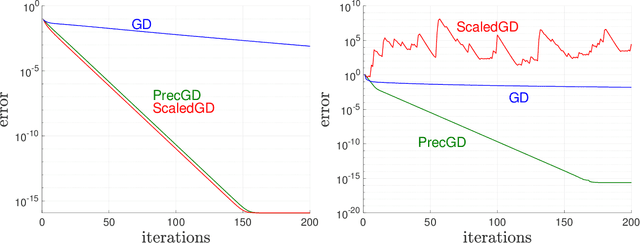
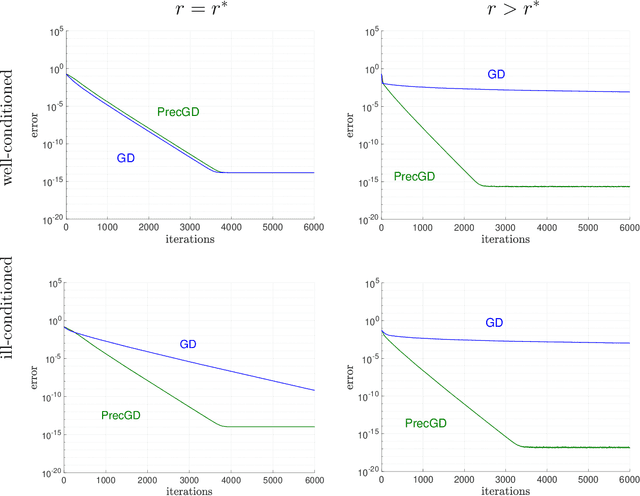
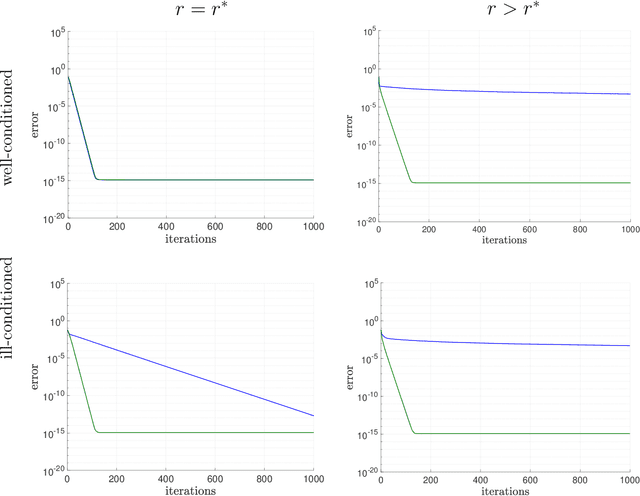
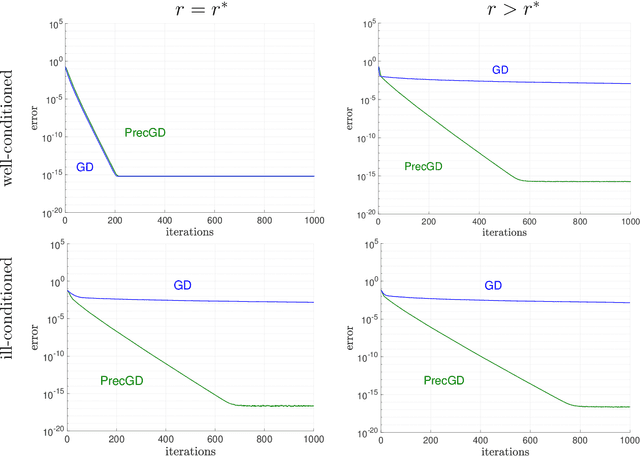
Abstract:We consider using gradient descent to minimize the nonconvex function $f(X)=\phi(XX^{T})$ over an $n\times r$ factor matrix $X$, in which $\phi$ is an underlying smooth convex cost function defined over $n\times n$ matrices. While only a second-order stationary point $X$ can be provably found in reasonable time, if $X$ is additionally rank deficient, then its rank deficiency certifies it as being globally optimal. This way of certifying global optimality necessarily requires the search rank $r$ of the current iterate $X$ to be overparameterized with respect to the rank $r^{\star}$ of the global minimizer $X^{\star}$. Unfortunately, overparameterization significantly slows down the convergence of gradient descent, from a linear rate with $r=r^{\star}$ to a sublinear rate when $r>r^{\star}$, even when $\phi$ is strongly convex. In this paper, we propose an inexpensive preconditioner that restores the convergence rate of gradient descent back to linear in the overparameterized case, while also making it agnostic to possible ill-conditioning in the global minimizer $X^{\star}$.
How Many Samples is a Good Initial Point Worth?
Jun 12, 2020

Abstract:Given a sufficiently large amount of labeled data, the non-convex low-rank matrix recovery problem contains no spurious local minima, so a local optimization algorithm is guaranteed to converge to a global minimum starting from any initial guess. However, the actual amount of data needed by this theoretical guarantee is very pessimistic, as it must prevent spurious local minima from existing anywhere, including at adversarial locations. In contrast, prior work based on good initial guesses have more realistic data requirements, because they allow spurious local minima to exist outside of a neighborhood of the solution. In this paper, we quantify the relationship between the quality of the initial guess and the corresponding reduction in data requirements. Using the restricted isometry constant as a surrogate for sample complexity, we compute a sharp threshold number of samples needed to prevent each specific point on the optimization landscape from becoming a spurious local minima. Optimizing the threshold over regions of the landscape, we see that, for initial points not too close to the ground truth, a linear improvement in the quality of the initial guess amounts to a constant factor improvement in the sample complexity.
 Add to Chrome
Add to Chrome Add to Firefox
Add to Firefox Add to Edge
Add to Edge